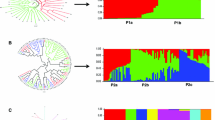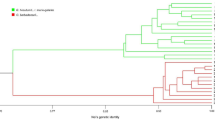Abstract
Cotton (Gossypium) has a long history of cultivation in Africa, witnessed by the presence of traditional cotton plants conserved in the villages. A collection of traditional cotton accessions conserved as perennial plants by farmers was made throughout Burkina Faso. The collection represents a wide range of diversity within the genus. Although the species G. hirsutum is the only cultivated species in the region, the collection of traditional cotton identified four major domesticated species based on morphological and botanical traits. It included diploid species G. arboreum and G. herbaceum, the latter represented by a single specimen, tetraploid species G. barbadense and G. hirsutum. Within G. hirsutum, annuals and perennials were distinguished. The genetic diversity and population structure of 121 accessions of the collection as assessed by SSR markers polymorphism clearly identified the 3 species, G. arboreum, G. barbadense and G. hirsutum; the G. herbaceum specimen was not distinguishable within G. arboreum group. The perennials and annuals forms within G. hirsutum were clearly separated. The persistence of those anciently cultivated cotton species and their maintenance by villagers is remarkable and fairly unique as they were introduced in the continent in the 16th century. This genetic resource could possess promising attributes related to environmental adaptation or to traditional uses and it needs to be properly characterized and preserved either in situ or ex situ.




Similar content being viewed by others
References
Abdalla AM, Reddy OUK, El-Zik KM, Pepper AE (2001) Genetic diversity and relationships of diploid and tetraploid cottons revealed using AFLP. Theor Appl Genet 102:222–229
Abdukarimov A (2007) Exploiting genetic diversity. In: Ethridge D (ed) Proceedings of World Cotton Research Conference-4, Omnipress for International Cotton Advisory Committee, Lubbock, p 2153
Abdurakhmonov I, Kohel RJ, Yu J, Pepper AE, Abdullaev A, Kushanov FN, Salakhutdinov IB, Buriev Z, Saha S, Scheffler B, Jenkins JN, Abdukarimov A (2008) Molecular diversity and association mapping of fiber quality traits in exotic G. hirsutum germplasm. Genomics 92:478–487
Alves MF, Barroso PAV, Ciampi AY, Hoffmann LV, Azevedo VCR, Cavalcante U (2013) Diversity and genetic structure among subpopulations of Gossypium mustelinum (Malvaceae). Genet Mol Res 12(1):597–609
Bassett TJ (2006) The peasant cotton revolution in West Africa. Côte d’Ivoire, 1880-1995. Cambridge University Press, Cambridge
Belhkir K, Borsa P, Chikhi L, Raufaste N, Bonhomme F (2004) GENETIX 4.05, logiciel sous Windows TM pour la génétique des populations. Laboratoire Génome, Populations, Interactions, CNRS UMR5000, Université de Montpellier, Montpellier, France
Bèye A (1989) Etude des cotonniers sub-spontanés du Sénégal et de la Gambie: identification de quatre types de cotonniers. In: UNIVAL (ed). ISRA, p 18
Bourgou L, Sanfo D, Tiemtore CB, Traore O, Sanou J, Traore K (2013) Assessment of Bollgard II cotton pollen mediated transgenes flow to conventional cotton in the farming conditions of Burkina Faso. Afr J Biotechnol 33:5192–5199
Bourgou L, Tarpaga WV, Sanfo D, Sawadogo M, Zongo JD (2014) Préservation de la diversité génétique dans le genre Gossypium au Burkina Faso: collecte et évaluations préliminaires de cotonniers locaux. Int J Biol Chem Sci 5:2081–2094
Brink M (2011) Gossypium arboreum L. Record from PROTEA4U. Brink M & Achigan-Dako EG (Eds). PROTA Plant Resources of Tropical Africa, http://www.prota4u.org/, Wageningen
Brubaker CL, Bourland FM, Wendel JF (1999) The origin and domestication of cotton. In: Smith CW, Cothren JT (eds) Cotton, origin, history, technology and production. Wiley Series in crop science, Wiley, New York, pp 3–31
Campbell BT, Saha S, Percy RG, Frelichowski JE, Jenkins JN, Park W, Mayee CD, Gotmare V, Dessauw D, Giband M, Du X, Jia Y, Constable GA, Dillon S, Abdurakhmonov I, Abdukarimov A, Rizaeva SM, Adullaev A, Barroso PAV, Padua JG, Hoffmann LV, Podolnya L (2010) Status of global cotton germplasm resources. Crop Sc 50:1161–1179
Chevalier A (1948) Systématique des Cotonniers cultivés ou ayant été cultivés anciennement en Afrique tropicale. Rev Int Bot Appl Agr Trop n 307–308:228–241
Clark LV, Drauch Schreier A (2015) Resolving microsatellite genotype ambiguity in populations of allopolyploid and diploidized autopolyploid organisms using negative correlations between alleles. http://doi.org/10.1101/020610, Available on BioRxiv
Clive J (2014) Global status of commercialized Biotech/GM crops. ISAAA Brief No49. ISAAA: Ithaca, New-York
Coppens d’Eeckenbrugge G, Lacape JM (2014) Distribution and Differentiation of Wild, Feral, and Cultivated Populations of Perennial Upland Cotton (Gossypium hirsutum L.) in Mesoamerica and the Caribbean. PLoS ONE 9:e107458
de Menezes IPP, Gaiotto FA, Hoffmann LV, Ciampi AY, Barroso PAV (2014) Genetic diversity and structure of natural populations of Gossypium mustelinum, a wild relative of cotton, in the basin of the De Contas River in Bahia, Brazil. Genetica 1:99–108
de Menezes IPP, Hoffmann LV, Barroso PAV (2015) Genetic characterization of cotton landraces found in the Paraiba and Rio Grande do Norte states. Crop Breed Appl Biot 1:26–32
Dempewolf H, Hodgins KA, Rummell SE, Ellstrand NC, Rieseberg LH (2012) Reproductive isolation during domestication. Plant Cell 7:2710–2717
Dongre A, Bhandarkar M, Banerjee S (2007) Genetic diversity in tetraploid and diploid cotton (Gossypium spp.) using ISSR and microsatellite DNA markers. Indian J Biotech 6:349–353
Earl DA, von Holdt BM (2012) STRUCTURE HARVESTER: a website and program for visualizing STRUCTURE output and implementing the Evanno method. Conserv Genet Resour 4(4):359–361. doi:10.1007/s12686-011-9548-7
Evanno G, Regnau S, Goudet J (2005) Detecting the number of clusters of individuals using the software STRUCTURE: a simulation study. Mol Ecol 14(8):2611–2620
Fryxell PA (1976) A nomenclator of gossypium : the botanical names of cotton. Tech Bull No. 1491. United States Department of Agriculture, Washington
Goudet J (1995) FSTAT (Version 1.2): a computer program to calculate F-statistics. J Hered 6:485–486
Govindaraj M, Vetriventhan M, Srinivasan M (2015) Importance of genetic diversity assessment in crop plants and its recent advances: an overview of its analytical perspectives. Genet Res Int. doi:10.1155/2015/431487, 14
Guo WZ, Zhou BL, Yang LM, Wang W, Zhang TZ (2006) Genetic diversity of landraces in Gossypium arboreum L. race sinense assessed with simple sequence repeat markers. J Integr Plant Biol 9:1008–1017
Hammer K (2004) Resolving the challenge posed by agrobiodiversity and plant genetic resouces-an attempt. J Agr Rural Dev Trop, Beiheft Nr. 76, pp 184
Hutchinson JB (1949) The dissemination of cotton in Africa. Empire Cotton Grow Rev 27:123
Hutchinson JB (1951) Intra-specific differentiation in Gossypium hirsutum. Heredity 5:169–193
Hutchinson JB (1954) New evidence on the origin of the old world cottons. Heredity 8–2:225–241
Kantartzi S, Ulloa M, Sacks E, Stewart JM (2009) Assessing genetic diversity in Gossypium arboreum L. cultivars using genomic and EST-derived microsatellites. Genetica 1:141–147
Khangura RS, Singh L, Pathak D, Gill M, Sohu R (2014) Assessment of genetic diversity in Desi cotton (Gossypium arboreum L.). J Res Punjab agric Univ 2:101–104
Lacape J-M, Dessauw D, Rajab M, Noyer JL, Hau B (2007) Microsatellite diversity in tetraploid Gossypium gene pool: assembling a highly informative genotyping set of cotton SSRs. Mol Breed 19:45–58
Liu S, Cantrell RG, Mc Carty JCJ, Stewart JM (2000) Simple sequence repeat-based assessment of genetic diversity in cotton race stock accessions. Crop Sc 40:1459–1469
Liu D, Guo XP, Lin Z, Nie YC, Zhang X (2006) Genetic diversity of Asian cotton (Gossypium arboreum L.) in China evaluated by microsatellite analysis. Genet Resour Crop Evol 53:1145–1152
Moiana LD, Vidigal Filho PS, Gonçalvez-Midigal MC, de Carvolho LP (2015) Genetic diversity and population structure of upland cotton Brazilian cultivars (Gossypium hirsutum L.) using SSR markers. Aus J Crop Sci 2:143–151
Percival AE, Wendel JF, Stewart JM (1999) Taxonomy and germplasm resources. In: Smith CW, Cothren JT (eds) Cotton Origin, history, technology, and production. Wiley, New York, pp 33–63
Père M (2004) Le royaume Gan d’Obiré: introduction à l’histoire et à l’anthropologie. Burkina Faso, Saint-Maur-des-Fossés (FR)
Perrier X, Jaquemoud Collet JP (2006) DARwin software http://darwin.cirad.fr/darwin
Pritchard JK, Stephens M, Donnelly P (2000) Inference of population structure using multilocus genotype data. Genetics 155:945–959
Rahman M, Yasmin T, Tabbasam N, Ullah I, Asif M, Zafar Y (2008) Studying the extent of genetic diversity among Gossypium arboreum L. genotypes/cultivars using DNA fingerprinting. Genet Resour Crop Evol 3:331–339
Saitou N, Nei M (1987) The neighbor-joining method: a new method for reconstructing phylogenetic trees. Mol Biol Evol 4:406–425
Sauer JD (1993) Historical geography of crop plant. In: A select restor. CRC press Boca Raton, Florida, p 309
Seignobos C, Schwendiman J (1991) Traditional cotton plants in Cameroon. Cot Fib Trop 46(4):322–332
Sethi KV, Siwach P, Sethi K (2014) Genetic improvement of Gossypium arboreum L. using molecular markers: status and development needs. Afr J Agr Biotech 29:2238–2249
Sethi K, Siwach P, Verma S (2015) Assessing genetic diversity among six populations of Gossypium arboreum L. using microsatellites markers. Physiol Mol Biol Plants 4:531–539
Singh VV, Mohan P, Kulkarni VN, Baitule SJ, Pathak BR (2003) Explorations within India for collection of cotton species germplasm. PGR Newsl 136:40–46
Stewart JM (1994) Potential for crop improvement with exotic germplasm and genetic engineering. In: Constable GA, Forrester NW (eds) Challenging the future, Proc World Cotton Res Conf -1, Brisbane (Austr.), pp. 313–327
Todou G, Konsala S (2011) Gossypium barbadense L.. Record from PROTA4U. Brink M, Achigan-Dako EG (Eds). PROTA Plant Resources of Tropical Africa, http://www.prota4u.org/, Wageningen
Ulloa M, Stewart JM, Garcia EA, Godoy S, Gaytan A, Acosta S (2006) Cotton genetic resources in the Western states of Mexico: in situ conservation status and germplasm collection for ex situ preservation. Genet Resour Crop Evol 53(4):653–668
Ulloa M, Abdurakhmonov I, Perez-Mendoza C, Percy RG, Stewart JM (2013) Genetic diversity and population structure of cotton (Gossypium spp.) of the New World assessed by SSR markers. Botany 91:251–259
Varshney RK, Graner A, Sorrells ME (2005) Genic microsatellite markers in plants: features and applications. Trends Biotechnol 1:48–55
Watt G (1907) The wild and cultivated cotton plants of the world. Longmans, Green and Co, London
Wendel JF, Cronn RC (2003) Polyploidy and the evolutionary history of cotton. Adv Agron 78:140–186
Wendel J, Grover CE (2015) Taxonomy and evolution of the cotton genus, Gossypium. In: Fang D, Percy RG (eds) Cotton, agronomy monograph 57. ASA, CSSA, Madison, p 20
Wendel JF, Brubaker CL, Seelenan T (2010) The origin and evolution of Gossypium. In: Stewart JM, Oosterhuis DM, Heitholt JJ, Mauney JR (eds) Physiology of cotton. Springer, Dordrecht, pp 1–18
Acknowledgements
We are grateful to Diané K. Sidiki and Ouattara Brahiman for help in field work, Ronan Rivallan for help in laboratory work, to Ouattara Marcel for help in graphical representations, and finally to our colleagues Geo Coppens d’Eeckenbrugge, Vernon Gracen and Dominique Dessauw for critical reading of an earlier version of the manuscript. This research was supported by Projet Paficot INERA and AI11 2014 and 2015 of Cirad.
Author information
Authors and Affiliations
Corresponding author
Ethics declarations
Conflict of interest
The authors declare that they have no conflict of interest.
Electronic supplementary material
Below is the link to the electronic supplementary material.
Rights and permissions
About this article
Cite this article
Bourgou, L., Sawadogo, M., Sanfo, D. et al. SSR-based genetic diversity of traditional and perennial cotton (Gossypium spp.) populations collected in Burkina Faso. Genet Resour Crop Evol 64, 1743–1759 (2017). https://doi.org/10.1007/s10722-016-0470-4
Received:
Accepted:
Published:
Issue Date:
DOI: https://doi.org/10.1007/s10722-016-0470-4




